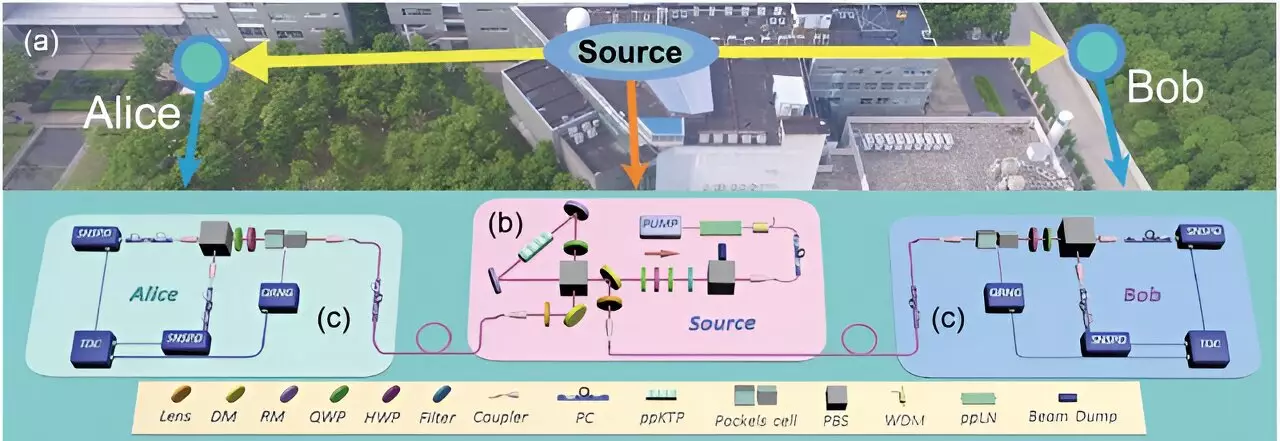In a significant leap for quantum physics, a research team spearheaded by the University of Science and Technology of China (USTC) has achieved a longstanding goal in quantum mechanics—effectively closing both the locality and detection efficiency loopholes in a test of Hardy’s paradox. Published in *Physical Review Letters* as an “Editor’s Suggestion,” this monumental study highlights the collaborative work of notable scientists, including Prof. Pan Jianwei, Zhang Qiang, and Chen Kai, alongside Nankai University’s Chen Jingling. The implications of their findings not only reinforce quantum theory but also challenge classical notions of local realism.
Introduced by Lucien Hardy in the 1990s, Hardy’s paradox presents a simplified experiment to test local realism—a principle that asserts that physical properties exist independently of observation and that no information can travel faster than light. Contrary to this classical view, Hardy’s paradox demonstrates situations in which local realism faces stark contradiction: while three predetermined “Hardy events” propose a zero probability, quantum mechanics asserts a non-zero probability for a fourth event. This fundamental discrepancy incites profound questions about the essence of reality.
However, the experimental validation of Hardy’s paradox is no small feat. Traditional approaches have stumbled upon two critical challenges: the locality loophole—the risk that the measurement settings could impact the outcomes—and the detection efficiency loophole, which arises from inevitable optical losses in photon detection. Prior attempts have failed to achieve a comprehensive resolution of these issues, leaving Hardy’s paradox largely unconfirmed.
In their pursuit of clarity, the research team introduced an innovative experimental setup that seamlessly addressed the locality loophole. They ensured that the choice of measurement was implemented in a manner that was spacelike separated from both the entangled state preparations and photon detections. This intricate design guarantees mutual independence among the measurement settings, effectively distancing them from potential influences of the experimental outcomes.
To further eliminate the detection efficiency loophole, the researchers achieved an unprecedented detection efficiency of 82.2%. This high efficiency significantly mitigated the challenges posed by optical noise. Additionally, by harnessing high-speed quantum random number generators for determining measurement settings, the study incorporated a critical component of randomness, thus enhancing the experiment’s robustness against local hidden variable theories.
The culmination of the experiment was nothing short of astonishing. Running for six hours, the team executed 4.32 billion trials, resulting in a notable violation of Hardy’s paradox that reached a significance level of 5 standard deviations. A null hypothesis testing further reinforced the findings, presenting a staggering probability of less than 10^(-16348) for the results to be explained under local realism. This suite of evidence substantively bolsters the case for quantum nonlocality, underscoring the limitations of classical interpretations of physical laws.
Implications and Future Directions
The ramifications of this breakthrough are vast and multifaceted. As we deepen our understanding of quantum mechanics, the potential applications of these findings extend beyond theoretical interest, paving the way for exciting advancements in quantum technology. Fields such as quantum key distribution and quantum random number certification stand to benefit substantially from this work, driving forward the development of secure communication systems and enhancing the functionalities of quantum computers.
The experimental success outlined in this research marks a significant milestone in the quest to substantiate quantum mechanics, and it offers newfound evidence for the nonlocality principle rooted at the core of quantum theory. As we move forward, this work not only enriches the landscape of quantum physics but also illuminates a path toward transformative innovations in technology that we are just beginning to comprehend. The ability to reconcile Hardy’s paradox represents a profound shift in our understanding of reality, opening doors to novel explorations in the quantum realm.


Leave a Reply